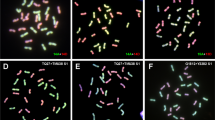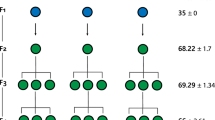Abstract
Seeds of a variety of allogamous Brown Sarson (Brassica campestris) were irradiated with gamma rays either before or after duplication of their chromosome number by colchicine. Tetraploids from seeds irradiated before duplication had mean quadrivalent and chiasma frequencies of 1.85 and 28.35 respectively. Those from seeds irradiated after duplication had frequencies of 2.82 and 29.94, while unirradiated tetraploids had 2.77 and 30.53 respectively. Small structural aberrations inducing preferential pairing are assumed to have caused the lower quadrivalent frequency after the first treatment. The results suggest that it may be more expedient to induced, allopolyploidlike chromosome behaviour by irradiation at the diploid than at the tetraploid level.
Similar content being viewed by others
References
Ahloowalia, B. S. (1963). Study of a translocation in tetraploid rye.Genetica 33: 207–221.
Bremer, G. &D. E. Bremer-Reinders (1954). Breeding of tetraploid rye in the Netherlands. 1. Methods and Cytological investigations.Euphytica 3: 49–63.
Cua, L. D. (1952). Artificial polyploidy inOryza. III. Cytogenetical studies on intra- and intersubspecies tetraploid hybrids onOryza sativa L.Seiken Ziho/Rep. Kihara Inst. Biol. Res. 5: 42–53.
Doyle G. G. (1963). Preferential pairing in strucutural heterozygotes ofZea mays.Genetics 48: 1011–1027.
Garber, E. D. &T. S. Dhillon (1962). The genusCollinsia XVII. Preferential pairing in four amphidiploids and three triploid interspecific hybrids.Canad. J. Genet. Cyt. 4: 6–13.
Giles A &L. F. Randolph (1951). Reduction of quadrivalent frequency in autotetraploid maize during a period of 10 years.Amer. J. Bot. 38: 12–17.
Linnert, G. (1962). Untersuchungen an hemiploiden Nachkommen Autotetraploider. I.Z. Vererbungslehre 93: 389–398.
Myers, W. M. &H. D. Hill (1943). Increased meiotic irregularity accompanying inbreeding inDactylis glomerata L.Genetics 28: 383–397.
Müntzing, A. &R. Prakken (1940). The mode of chromosome pairing inPhleum twins with 63 chromosomes and its cytological consequences.Hereditas 26: 463–501.
Shaver, D. L. (1963). The effect of structural heterozygosity on the degree of preferential pairing in autotetraploids ofZea.Genetics 48: 515–524.
Stebbins, G. L. (1956). Artificial polyploidy as a tool in plant breeding.Brookhaven Symp. Biol. 9: 37–52.
Stephens, S. G. (1950). The internal mechansim of speciation inGossypium.Bot. Rev. 16: 115–149.
Sybenga, J. (1966). The role of meiotic chromosome pairing pattern in induced structural allopolyploidization of autopolyploids.Acta Agriculturae Scandinavica, Suppl.16: 43–45.
Swaminathan, M. S. &K. Sulbha (1959). Multivalent frequency and seed fertility in raw and evolved tetraploids ofBrassica campestris var. toria.Z. Vererbungslehre 90: 385–392.
Author information
Authors and Affiliations
Rights and permissions
About this article
Cite this article
Srinivasachar, D., Singh, K.P. Induced allopolyploidization of autotetraploidBrassica campestris . Genetica 38, 375–380 (1967). https://doi.org/10.1007/BF01507468
Received:
Issue Date:
DOI: https://doi.org/10.1007/BF01507468




